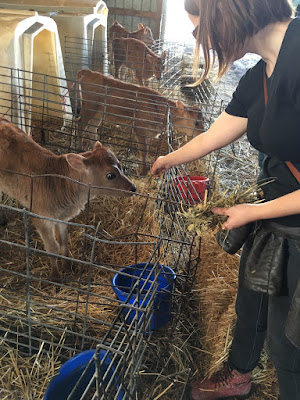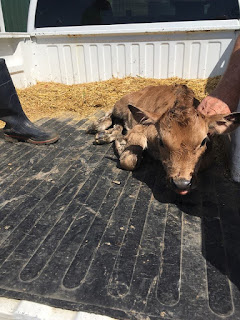Midwesterners have a lot of road trip games centered around cows. A popular one in college was every time you saw a field of cows, the first person to say “Cow” got a point. If you saw a body of water, the first person to say “Body of Water” erased everyone else’s points. The person with the most points at the end of the road trip won.
It’s an exciting world here in the Midwest.
This life is misleading. These games may illustrate just how dull the scenery can be driving through middle America, but they don’t illustrate how the meat and dairy industry generally operates. A field of free range livestock is an anomaly. Most of our animal products come from a far worse reality. Truly gross stuff that not only treats animals inhumanely, but is also a huge contribution to greenhouse gases and waste issues.
However, as a human, I love to eat meat and dairy. The day I realized I could get zero waste cheese was life-changing for me. So while I respect those who choose vegetarianism or veganism, I believe supporting sustainable farms and organizations is a more effective way of using my dollar to make a difference in the food industry.
Luckily, living in the Midwest and having other badass hippie friends has made finding sustainable farms easy. Last weekend I had the chance to visit Ropp Jersey Cheese outside of Normal, IL and get a taste of what the food industry could be.
Sustainable Farms Are Not What I Expected
By that, I mean the farm in no way resembled a bunch of long haired, long skirted cult members standing around tossing seed at a bunch of chickens.
The People
Until recently, my only experience with farmers were caricatures on television. They’re depicted as either flower children like the video above or as toothless rednecks with a piece of hay sticking out of their mouths.
These stereotypes are, of course, absurd and offensive. The farmers we met at Ropp Jersey Cheese were just people running a business. In fact, when we called ahead asking if we could tour their facility, they answered with a confused, “We don’t do tours, but you’re welcome to come and look around.” Which is exactly what we did. The employees were pretty hands-off. They checked us out when we were ready to buy, but otherwise went around their business and left us alone.
The Animals
I have interacted with animals on two different levels: pets and wild animals. Humanely treated farm animals fall somewhere in between and I wasn’t entirely prepared for that.
The Ropp cows certainly were not pets–only the young ones wanted anything to do with us–but they weren’t the bundle of fight or flight reflexes you see in wild animals.
I’m not sure what I was expecting. Maybe some sort of Disney version of farm animals. But much like the the dairy farm’s employees, the cows were just doing their thing. Hanging out, running around the field, eating, sleeping. You know, being cows.
The Products
A lot of organic eating die-hards will try to convince me that naturally produced food tastes better than heavily processed food. However, my own experience has proven this claim false. The only thing that tastes better than processed food is food made by someone who knows how to cook. Nothing I make in the kitchen comes close to tasting as good as a quarter pounder with cheese meal from McDonalds, organic or no.
The whole reason why not all meat and dairy is sustainable is because it’s hard to convince people to spend more money for less food that tastes just like cheap processed food. That said, Ropp’s products were cheaper than I expected. Unlike grocery stores, where they charge noticeably more for organic options, going straight to the source cuts out the middle man tax. A block of fancy-ish cheese was just over $5.50, about the same I would expect to pay at a grocery store for non-ethically sourced alternatives.
How to Eat Sustainable Meat & Dairy
If perchance my tale has inspired you to seek out your own sustainable meat and dairy, then never fear: you don’t have to travel all the way to a sustainable farm to achieve your dreams. Here are some easier habits that will set you on the right path:
Just eat less of it.
A lot of people see the world divided into two kinds of people: people who eat meat for every meal and vegetarians. The fact is, you don’t need that much meat and dairy to get your daily dose of calcium and protein if you choose to stay an omnivore. Simply reduce the amount of meat and dairy you eat every day and you’ll be living more sustainably. Remember: that includes milk, eggs, and other animal product food that isn’t meat.
In addition, there are plenty of plant based foods that you can supplement into a meat-free breakfast, lunch, or dinner for a protein punch. My favorites are:
- Rice and beans
- Quinoa
- Peanut butter
- Nut milk (almond milk, cashew milk, etc.)
- Edamame
Don’t trust labels.
Marketers will slap just about anything on a product if it will persuade you to buy it. Unfortunately, the public’s concern with where their food comes from has taken the path of so many fads before it. Here’s a short video that explains just how turbulent navigating Label Land can get:
Look for transparency.
Investigate. Ask questions. At Ropp, we could literally see the guys making cheese through a big window (and hear the rap music they were blasting). If a company or private farmer isn’t open to discussing or showing how they raise and process their meat and dairy, it’s far more likely that they are using unsustainable practices.
Build a relationship with butchers and farmers.
If you can’t make it out to the actual farms, then try to find people near you who know what they’re selling. Farmers markets and specialty shops are a good place to start. Try to go when it’s not busy and talk to them about their products.
Participate in hunting season.
These animals are the epitome of “free range” meat. They live their entire lives in the wild and there are many laws in place that limit the type and amount of animals you’re allowed to hunt.
In addition, when you have to deal with the whole animal yourself, you’re far more likely to make the most of it. Deer hunting season manages wild populations, especially since we’ve removed nearly all natural predators from the wild. While I don’t think hunting is a long-term sustainable answer to managing prey overpopulation, it is a far more sustainable way of meat production than cow and pig factories.
Use the whole buffalo.
Adventurous eating is a great way to stay sustainable. So much of the meat industry is determined by what’s popular to eat. As a result, a lot of animal parts that are edible get thrown away. Eating unusual cuts of meat (brains, noses, whatever!) wastes far less of the animal.
Before I go, I’d like to say a big thank you to Ropp Jersey Cheese for being so awesome.
Follow Up: Naming a Calf! (August 2017)
I’m thrilled to announce that my friend was given the opportunity to name on of Ropp Jersey Farm’s baby calves. Meet Bindi! She’s gonna live one great life on this sustainable farm. Thanks again, Ropp!


